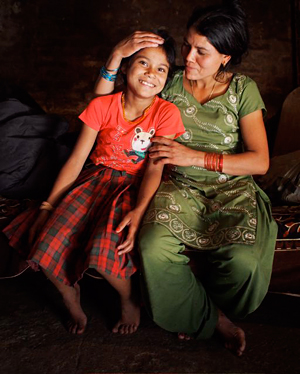
Mission
Hands in Outreach is a small, educational sponsorship program for poor, inner-city girls in Nepal. With a family oriented approach, HIO guides and empowers girls to become strong, self-reliant adults. The organization builds lasting relationships with families, children and affiliate schools, encouraging girls to remain in school, thus avoiding early marriage and a life of low-wage, menial jobs.
Life Challenges of the Women Served
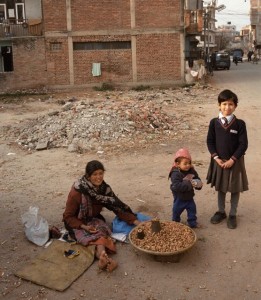 HIO serves girls ages 4 – 25 living in extreme poverty in Kathmandu. They live in urban poverty, usually without running water or power, sharing one room with the family. Without the assistance of HIO these girls will repeat the cycle of extreme poverty, illiteracy and dependence endured by their mothers. Under these conditions they are more likely to marry young, have children early, have poor health, and perform low paid, low skilled menial work that does not give them the opportunity to escape from the poverty trap. This situation leaves them vulnerable and at much greater risk of exploitation in domestic and sexual servitude, domestic violence and human trafficking. Since Nepal’s April 2015 earthquake, reports indicate that women and girls face a range of increased risks, including gender-based violence and sex trafficking.
HIO serves girls ages 4 – 25 living in extreme poverty in Kathmandu. They live in urban poverty, usually without running water or power, sharing one room with the family. Without the assistance of HIO these girls will repeat the cycle of extreme poverty, illiteracy and dependence endured by their mothers. Under these conditions they are more likely to marry young, have children early, have poor health, and perform low paid, low skilled menial work that does not give them the opportunity to escape from the poverty trap. This situation leaves them vulnerable and at much greater risk of exploitation in domestic and sexual servitude, domestic violence and human trafficking. Since Nepal’s April 2015 earthquake, reports indicate that women and girls face a range of increased risks, including gender-based violence and sex trafficking.
Women and girls living in extreme poverty in Nepal have little opportunity to change their lives. Factors that contribute to lower health outcomes for women and girls include the low status of girls and women, son preference, patrilineal inheritance, low education levels among women, and female shame about the body and reproductive functions. According to the United Nations Development Program, 48 percent of women in Nepal have experienced gender-based violence at least once in their lifetime. In Nepal, the average income for women is 57 percent lower than that of men. The literacy rate in Nepal is 71.6 per cent for men and 44.5 per cent for women.
The average monthly wage for HIO mothers is about $29 per month. Most are day laborers hauling bricks or mixing sand on construction sites. Many work as domestics – cooking, cleaning and washing clothing for other households. They pay an average of $15 per month for rent and about $10 per month for lentils, rice and some vegetables. There is little to nothing left for savings and contingencies.
The Project
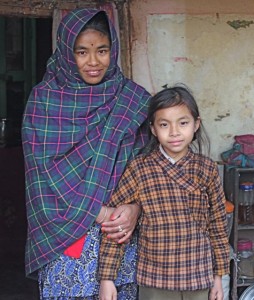 The goal of the program is to provide basic literacy, promote financial inclusion and encourage self-reliance. The women targeted by the program have little strategy for improving their lives and those of their children. These marginalized women are not poor because they lack initiative – they lack resources, opportunity and education. Without creating new opportunities for improved healthcare and education, their struggle with endemic, grinding poverty will continue consuming their lives.
The goal of the program is to provide basic literacy, promote financial inclusion and encourage self-reliance. The women targeted by the program have little strategy for improving their lives and those of their children. These marginalized women are not poor because they lack initiative – they lack resources, opportunity and education. Without creating new opportunities for improved healthcare and education, their struggle with endemic, grinding poverty will continue consuming their lives.
As a result of the program, 54 women from the most poverty stricken underclasses will, for the first time in their lives, have the chance to save money, be educated in basic financials and literacy, gain critical citizenship documents and begin a journey of empowerment and leadership. In effect, for the first time in their lives, these women will have the opportunity to move out of the entrapment of extreme poverty and have the ability to make autonomous choices in their lives and to gain the skills necessary to empower and move forward with their lives and pass this benefit along to their daughters.
The program aims to create a safety net where none now exists, providing a culturally sensitive program to help 54 mothers break an endless cycle of profound poverty. The core of the program gives small cash transfers to poor women, thus creating a modest, though vital base of financial stability. Each woman will be guided through obtaining Nepali citizenship in order to open a personal bank account. The program plans to provide each woman with a cash transfer of $20 per month for two years. Half of the cash will be saved and the remainder will be available for food, rent and the lost wages for participating in three, two-hour literacy classes each week. Too often, women cannot risk the loss of income by attending classes. They have the desire, but they cannot justify the work-time lost to learning. Regular attendance for the literacy class will be an agreed upon contingency for receiving their cash transfers. As an important teaching tool, each mother will be instructed how to use computers configured with innovative, early learning software recently set up at HIO’s Bal Kendra preschool. The mothers’ class will provide instruction for basic literacy in Nepali and English language, math skills, digital-fluency using the computer lab, regular health check-ups and vocational counseling. At the end of two years, mothers will save $240. Since HIO sponsors their daughters’ education, the organization is uniquely positioned to monitor the mothers’ saving and progress.
The project will indirectly benefit about 75 girls, the daughters of the women participating in the project. The girls will become project partners by helping their mothers practice reading and writing both in school and at home. The girls will become, in many cases, mentors and teachers for their mothers for literacy homework. The daughters will also see the benefits of education and savings plans that will be a positive marker and key beneficial outcome for their own development as young adults. Most of the girls in the program girls are raised by single illiterate mothers with no dependable means of support.
Women in Nepal have been taught emphatically since birth not to be leaders. This program will provide the tools and supportive learning environments for them to become comfortable leaders. By giving most of these women their first real financial stability, they will gain the courage to make their own decisions and the first real freedom to avoid domestic violence and dependency on their husbands. By necessity, many have already assumed leadership roles in guiding their family’s day-to-day survival. The literacy group will offer subtle and effective support, helping the women become confident role models for their children.
Sustainable Development Goals
![]()
![]()
![]()
![]()
Questions for Discussion
- How do you think tying cash transfers to literacy classes will make a difference in the lives of women in Nepal?
- How do you think having daughters as literacy partners for their mothers will impact the program?
- What could the long term effects be of empowering women in a patriarchal culture?
How the Grant Will be Used
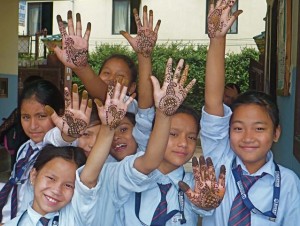 DFW’s donation of $44,290 over two years will pay for monthly cash transfers of $20 per month for two years to 54 women and a $50 bonus to each of the 54 women at the end of the program’s first year, software licenses and school supplies, teachers for classes, health checkups, legal costs for citizenship work, travel expenses and an in-country project coordinator.
DFW’s donation of $44,290 over two years will pay for monthly cash transfers of $20 per month for two years to 54 women and a $50 bonus to each of the 54 women at the end of the program’s first year, software licenses and school supplies, teachers for classes, health checkups, legal costs for citizenship work, travel expenses and an in-country project coordinator.
- Cash transfer: The heart of the project is a direct cash allotment to each woman of $20 per month for two years. She will use half to defray lost work income for the time spent in the literacy class. The other $10 is placed in a secure savings account for future use.
- Software licenses: Licenses for early learning software have been negotiated to half of regular price, down to $50 per student.
- Project Coordinator: A Nepali woman will act as project coordinator and be paid a monthly stipend. She will work closely with HIO to help implement and oversee the program along with evaluating and troubleshooting.
- Teachers: For the literacy class component of the project, the project will use two teachers who are qualified and experienced adult education teachers from a previous HIO mother’s literacy class.
- Travel and legal costs to obtain citizenship: Most, if not all the mothers do not have Nepali citizenship papers, a very common situation for the poor. As a result, their children are not considered Nepali citizens until they are registered with the government and have papers. Without Nepali citizenship papers, a person may not open a bank account. This will allow them to travel to the village of their husband’s birth to obtain the necessary documents.
- Educational supplies: This includes an allotment of $20 per year for general supplies.
- Bonus: Mothers receive a bonus of $50 for completing the first year of the project.
- Full health check-ups: Most of the mothers rarely see a doctor because of the expense. This will allow them to have a full exam with a female doctor.
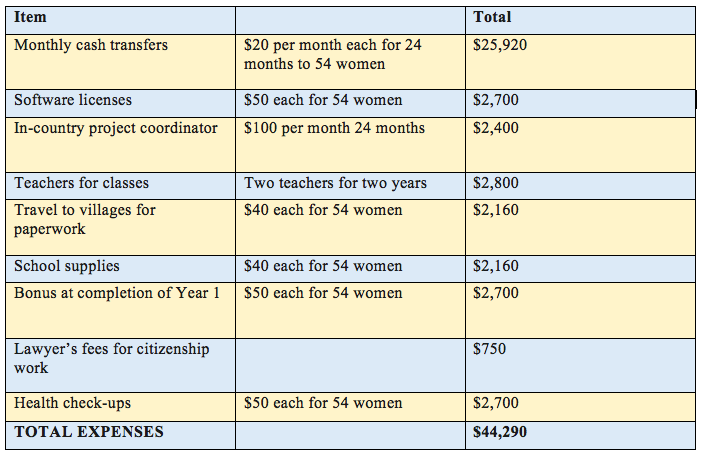
Why We Love This Project/Organization
We love this project because of its emphasis on strengthening the families of young, poor girls from marginalized communities in Nepal. By providing the mothers of these girls with education in basic financials and literacy, gaining critical citizenship documents and beginning savings accounts, Hands in Outreach is allowing both mothers and daughters to embark on a journey of empowerment and leadership.
Evidence of Success
Over 25 years, HIO has a proven track record of student retention topping 98 percent from kindergarten through college graduation in Nepal. The holistic style of social work, focusing on the long-term relationships established with sponsored girls and their families, allows a small staff to guide the welfare of the girls. Two girls sponsored through HIO were recently on full scholarships at Duke University and Georgetown University.
Voices of the Girls
 Every girl here began as HIO-sponsored students when they were 5 or 6 years old and all are now in college.
Every girl here began as HIO-sponsored students when they were 5 or 6 years old and all are now in college.
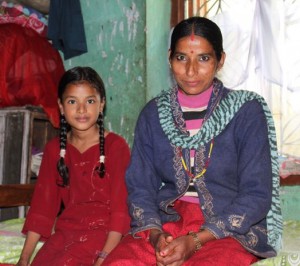 HIO sponsored third grader Depika with her mother Ganga, who rents a small cart that she parks on the street near their rented room. Ganga spends 10 – 12 hours on the road making snack foods, earning about $3 per day. After she pays the rent for the cart and the supplies, she nets about $1.25 per day to feed her family and pay for their rented room.
HIO sponsored third grader Depika with her mother Ganga, who rents a small cart that she parks on the street near their rented room. Ganga spends 10 – 12 hours on the road making snack foods, earning about $3 per day. After she pays the rent for the cart and the supplies, she nets about $1.25 per day to feed her family and pay for their rented room.
About the Organization
HIO was founded in 1985 by Donald Wilcox and Louise Todd Cope. The organization received non-profit status in 1987. In 2000, it began to shift away from having sponsored girls in boarding situations at its affiliate schools. Now, 99 percent of sponsored girls are day students, allowing the staff complete access to the home for frequent visits. This vital access allows HIO to monitor the home conditions and provide back-up medical or financial support when necessary, as well as the unique ability to serve as mentors for the girls.
Where They Work
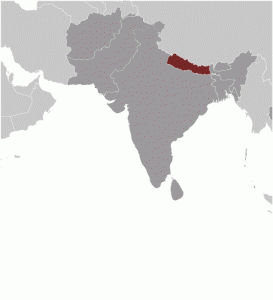
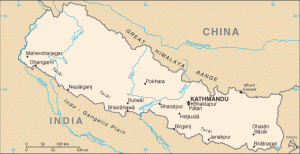 Nepal is a landlocked country between China and India. While Nepal appears tiny in comparison to the giants on either side of it, the country is roughly the size of Illinois. The population of Nepal is roughly 27 million. The country was ranked 145 out of 187 on the United Nations Development Programme’s (UNDP’s) 2014 Human Development Index and is one of the 31 countries classified by the World Bank as a “low-income” country. Nepal is a patriarchal country and has traditionally been one of the worst in the world for gender equality. It ranked overall 112 out of 142 in the Gender Gap Index 2014, according to the World Economic Forum.
Nepal is a landlocked country between China and India. While Nepal appears tiny in comparison to the giants on either side of it, the country is roughly the size of Illinois. The population of Nepal is roughly 27 million. The country was ranked 145 out of 187 on the United Nations Development Programme’s (UNDP’s) 2014 Human Development Index and is one of the 31 countries classified by the World Bank as a “low-income” country. Nepal is a patriarchal country and has traditionally been one of the worst in the world for gender equality. It ranked overall 112 out of 142 in the Gender Gap Index 2014, according to the World Economic Forum.
The country is rightly famous for claiming eight of the world’s ten highest peaks, including Mt. Everest. The fame of the Himalayas, however, often hides the rich geographic and ecological diversity that the country hosts. In fact, Nepal’s climate zones range from arctic to tropical. The southern belt of the country, called the “Terai,” is home to tigers, elephants, rhinos and other jungle flora and fauna.
Once various kingdoms, unification into one Nepal began in the late 18th Century. Unlike many countries in the region, Nepal was never colonized, despite ceding territory to the British after a border war in 1814. The country was almost entirely closed to foreigners until the early 1950s.
At that time, the country took its first steps toward democracy from monarchy, but the fledgling democracy was overturned by a royal coup in 1960. Democracy was re-introduced from 1990-1991, but the country suffered from a brutal civil war (the Maoist Insurgency) from 1996-2006. There were several interim governments, and failed constitutions, but as of September 2015, the country’s president announced a new permanent constitution.
In April 2015, a violent earthquake struck Nepal, killing more than 8,800 people and injuring more than 20,000.
A Closer Look
Financial literacy is important for women no matter where they live. The ability to spend efficiently and set savings goals means the same for a fashion designer in New York as it does for a seamstress in Kolkata. There are vast differences, however, in the financial education they require. In rich countries like the United States, women who lack financial literacy might struggle to understand a credit card agreement or the limits of an employer-subsidized retirement account. In the developing world, the failure to make educated financial decisions can mean the difference between survival and devastation for women and their families. With recent innovations making it possible for even the poorest women to open savings accounts or get loans, understanding how to access financial services has taken on new urgency. According to survey results supported by the World Bank (1), uneducated, low-income women are the most responsive to financial programs like that offered by Hands in Outreach. And as it turns out, when women make more financial decisions in a household, their spending tends to benefit families both immediately and into the future.
Although poverty levels have been falling worldwide, the United Nations Development Programme estimates that almost 1.5 billion people in developing countries are living in poverty. Worryingly, another 800 million people are in danger of falling back into poverty when faced with financial setbacks. (2) Women are particularly vulnerable because of the uncertainty of the informal economies in which many operate. In Nepal and other South Asian countries like Afghanistan, Bangladesh, Pakistan and Sri Lanka, 80 percent of women doing nonagricultural work are employed informally. (3) Only 26 percent of adults in the region have formal bank accounts. (4) When adversity strikes – like illness, the loss of a partner or a natural disaster – savings to cover an income shortfall are rare or at risk, stored in cash at home or in the form of excess stock in a market stall. Faced with a crisis, the most obvious first step will be to cut spending, even on the most critical needs. Necessary loans might come from family or friends, or in worst case scenarios, a loan shark with extremely high rates of interest.
Financial literacy programs help low-income women in developing countries find solutions to their most pressing economic problems. Students learn to budget, set savings goals and weigh the benefits of taking on inexpensive debt. They become less vulnerable, able to cope with crises and tackle recurring costs and efficient managers of both household incomes and profitable microenterprise activities.
The families of newly financially literate women benefit directly from this stability. A World Bank report has shown that household spending changes in ways that improve the lives of children once women control a greater share of the budget. Women will ensure more nutritious food for their families (5). They will budget for school fees and healthcare. (6) One study has even shown that women and girls reinvest 90 percent of their earnings into their families. (7)
The benefits of financial literacy reach beyond immediate needs: they are intergenerational as well. In a report addressing the importance of financial education for women, the Organisation for Economic Co-operation and Development stressed that “women have a major role in the transmission of financial habits and skills to their children.” (8) When women make good decisions with their money, their daughters learn to do the same. This relationship is known as the multiplier effect. As daughters go forward into households of their own, applying the principles of skillful money management learned from their mothers, these young women will be doing more than securing the stability of their own families – they will play a role in interrupting the cycle of poverty.
Source Materials
(1) Valuing Financial Literacy: Evidence from Indonesia (2) 2.2 billion people are poor or near-poor, warns 2014 Human Development Report on vulnerability and resilience (3) Facts and Figures: Economic Empowerment (4) The Global Findex Database (5) World Bank, World Development Report, 2012: Gender Equality and Development (6) Small Wonder: Helping the Poor to Save (7) Girls ‘Best Investment’ to Fight Poverty (8) Organisation for Economic Co-operation and Development, Addressing Women’s Needs for Financial Education
